
Dungeonland (EX1) is a 1983 adventure module for the Dungeons & Dragons (D&D) roleplaying game, written by Gary Gygax for use with the First Edition Advanced Dungeons & Dragons (AD&D) rules. It is an adaptation of Lewis Carroll's 1865 novel Alice's Adventures in Wonderland, with the various characters from the book translated into AD&D terms.
Abeir-Toril is the fictional planet that makes up the Forgotten RealmsDungeons & Dragons campaign setting, as well as the Al-Qadim and Maztica campaign settings, and the 1st edition version of the Oriental Adventures campaign setting.

Oriental Adventures is the title shared by two hardback rulebooks published for different versions of the Dungeons & Dragons (D&D) fantasy roleplaying game. Each version of Oriental Adventures provides rules for adapting its respective version of D&D for use in campaign settings based on the Far East, rather than the medieval European setting assumed by most D&D books. Both versions of Oriental Adventures include example campaign settings.

Scourge of the Slave Lords (A1–4) is an adventure module for the Dungeons & Dragons fantasy role-playing game, published by TSR, Inc. in 1986. It combines the contents of four earlier modules, all set in the World of Greyhawk campaign setting and intended for use with Advanced Dungeons & Dragons first edition rules.

Beyond the Crystal Cave is a Dungeons & Dragons module set in the World of Greyhawk campaign setting. It is unusual among Dungeons & Dragons modules in that it encourages a non-violent approach to achieving the module's goals. It is set in an old English milieu on Sybarate Isle in the Hold of the Sea Princes.

The Hidden Shrine of Tamoachan is an adventure module for the Dungeons & Dragons (D&D) fantasy role-playing game, set in the World of Greyhawk campaign setting for use with the 1st edition Advanced Dungeons & Dragons rules. It is the first in the C-series of modules, a set of unrelated adventures originally designed for competitive play, with the C representing the first letter in the word competition. It is the first D&D adventure to use boxed, "read aloud" text.
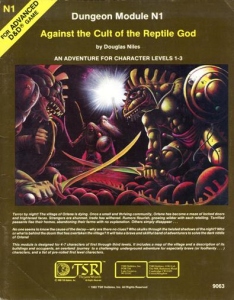
Against the Cult of the Reptile God is an adventure module for the first edition of the Advanced Dungeons & Dragons fantasy roleplaying game, set in the game's World of Greyhawk campaign setting. It is designed for novice players and gamemasters. The suggested party size is 4-7 characters of level 1-3.
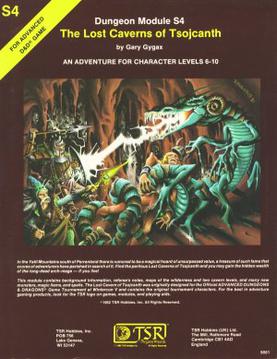
The Lost Caverns of Tsojcanth is an adventure module for the Dungeons & Dragons fantasy role-playing game. It was written by Gary Gygax and published by TSR in 1982 for the first edition Advanced Dungeons & Dragons (AD&D) rules. The 64-page adventure bears the code "S4" and is set in the Greyhawk campaign setting. It is divided into two parts, a 32-page adventure, and a 32-page booklet of monsters and magic items. The plot involves the player characters investigating rumors of lost treasure. After traversing a wilderness and two levels of dungeons, the players face Drelnza, the vampiric daughter of long-deceased archmage Iggwilv.
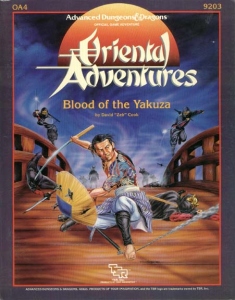
Blood of the Yakuza is a module in the Oriental Adventures subset of the Advanced Dungeons & Dragons Forgotten Realms product line.

David "Zeb" Cook is an American game designer, best known for his work at TSR, Inc., where he was employed for over fifteen years. Cook designed several games, wrote the Expert Set for Dungeons & Dragons, worked as lead designer of the second edition of Advanced Dungeons & Dragons, and invented the Planescape setting for AD&D. He is a member of the Origins Hall of Fame.
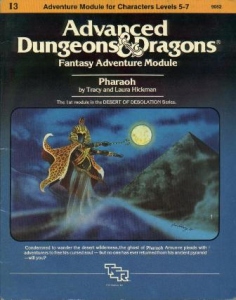
Pharaoh is an adventure module for the Dungeons & Dragons fantasy role-playing game. The module was published in 1982 by TSR, Inc. for the first edition Advanced Dungeons & Dragons rules. It formed the first of the three-part Desert of Desolation module series. The module was written by Tracy and Laura Hickman; Tracy Hickman would later go on to help create the Dragonlance campaign setting.

Desert of Desolation is a compilation adventure module published by TSR for the Dungeons & Dragons (D&D) fantasy roleplaying game. It combines three previously published individual modules: Pharaoh, Oasis of the White Palm, and Lost Tomb of Martek. The modules were made for use with the first edition Advanced Dungeons & Dragons (AD&D) rules. Pharaoh was created by Tracy and Laura Hickman soon after the couple married in 1977, and published by TSR in 1982. Oasis of the White Palm was a collaboration between Tracy Hickman and Philip Meyers, and Hickman wrote the Lost Tomb of Martek on his own; both were printed in 1983.

The Veiled Society is an adventure module for the Basic Rules of the Dungeons & Dragons fantasy role-playing game published in 1984. The adventure's product designation is TSR 9086.

Night's Dark Terror is an adventure module for the Dungeons & Dragons (D&D) fantasy role-playing game written by British game designers Jim Bambra, Graeme Morris, and Phil Gallagher. It was designed specifically for campaigns transitioning from the D&D Basic Set to the D&D Expert Set. The player characters (PCs) journey from a farmstead into uncharted wilderness, where they encounter new hazards and contend with a secret society. The adventure received a positive review from White Dwarf magazine.
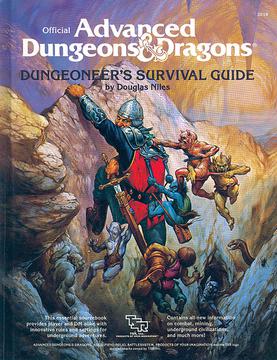
Dungeoneer's Survival Guide is a supplement to the Dungeons & Dragons fantasy role-playing game. The book was written by Douglas Niles, and published by TSR, Inc. in 1986.

Dwellers of the Forbidden City is an adventure module, or pre-packaged adventure booklet, ready for use by Dungeon Masters in the Dungeons & Dragons (D&D) fantasy role-playing game. The adventure was first used as a module for tournament play at the 1980 Origins Game Fair, and was later published by TSR in 1981 for use with the first edition Advanced Dungeons & Dragons rules. The module was written by game designer David "Zeb" Cook, who partly ascribes his hiring by TSR to his work on this module. In the adventure, the characters are hired to recover a stolen object from a hidden oriental-style city ruled by a snake-worshipping cult of yuan-ti and their mongrelmen and tasloi servants.
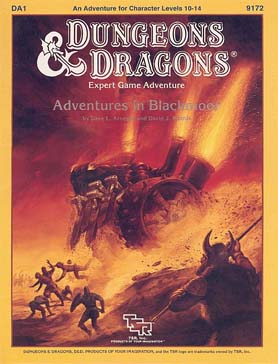
Adventures in Blackmoor is a 64-page Dungeons & Dragons fantasy role-playing game adventure, designed to be compatible with the Dungeons & Dragons Expert Set.
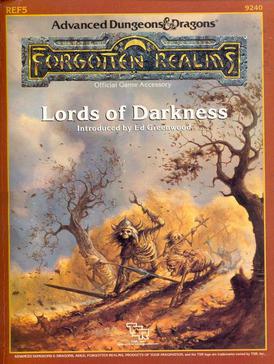
Lords of Darkness is the name of two accessories for the fictional Forgotten Realms campaign setting for the Dungeons & Dragons fantasy role-playing game.

Night of the Seven Swords is a 1986 adventure module for the Oriental Adventures rules of the Advanced Dungeons & Dragons fantasy role-playing game.
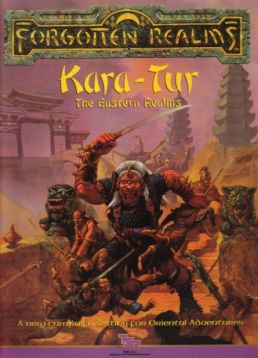
Kara-Tur: The Eastern Realms is an accessory and campaign setting for the Advanced Dungeons & Dragons fantasy role-playing game.


















